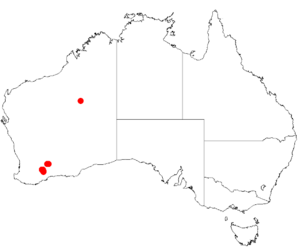Wooly wattle facts for kids
Quick facts for kids Wooly wattle |
|
|---|---|
| Conservation status | |
| Scientific classification | |
| Genus: |
Acacia
|
| Species: |
lanuginophylla
|
 |
|
| Occurrence data from Australasian Virtual Herbarium | |
The woolly wattle (scientific name: Acacia lanuginophylla) is a special type of shrub. It belongs to the Acacia family, which is also known as wattles. This plant is found only in the southwestern part of Australia. It is considered a vulnerable species, meaning it is at risk of disappearing. This status is given under a law called the Environment Protection Biodiversity Conservation Act 1999.
What Does It Look Like?
The woolly wattle is a shrub that usually grows between 0.5 to 1.2 metres (2 to 4 ft) tall. It can be dense and bushy, or more open and spreading. Its young branches are covered in soft, woolly hairs and are a yellow-green color.
Like most Acacia plants, the woolly wattle doesn't have true leaves. Instead, it has flattened leaf stems called phyllodes. These phyllodes are also very woolly and have a grey-green color. They are shaped like narrow ellipses or oblongs, measuring about 1.5 to 4 cm (0.59 to 1.57 in) long and 3.5 to 10 mm (0.14 to 0.39 in) wide. You can see three main lines (nerves) running along them, plus some smaller ones.
This plant blooms with bright yellow flowers from July to October.
Where Does It Live?
The woolly wattle grows naturally in the Wheatbelt and Goldfields-Esperance areas of Western Australia. You can often find it growing along small streams or in flat areas. It prefers soils that are a mix of clay and sand, or sandy and gravelly. It grows as part of open mallee forests, which are woodlands with short, multi-stemmed eucalyptus trees, and low scrub plants.
Sadly, there are only a few groups of woolly wattles left. Scientists have found only nine main populations, or fifteen smaller groups, remaining. They estimate there are about 5,483 individual plants left. Most of these are found in the Shire of Lake Grace and Shire of Yilgarn. Over 75% of the natural plant areas in these regions have been cleared, which is why the woolly wattle is now a vulnerable species.
How It Got Its Name
This plant was first officially described by two botanists, Bruce Maslin and Richard Sumner Cowan, in 1990. They wrote about it in a scientific paper. Later, in 2003, another botanist named Leslie Pedley changed its scientific name for a short time. But by 2005, it was changed back to its original name, Acacia lanuginophylla.


